steering wheel adjustment CHEVROLET CAMARO 1967 1.G Chassis Workshop Manual
[x] Cancel search | Manufacturer: CHEVROLET, Model Year: 1967, Model line: CAMARO, Model: CHEVROLET CAMARO 1967 1.GPages: 659, PDF Size: 114.24 MB
Page 18 of 659
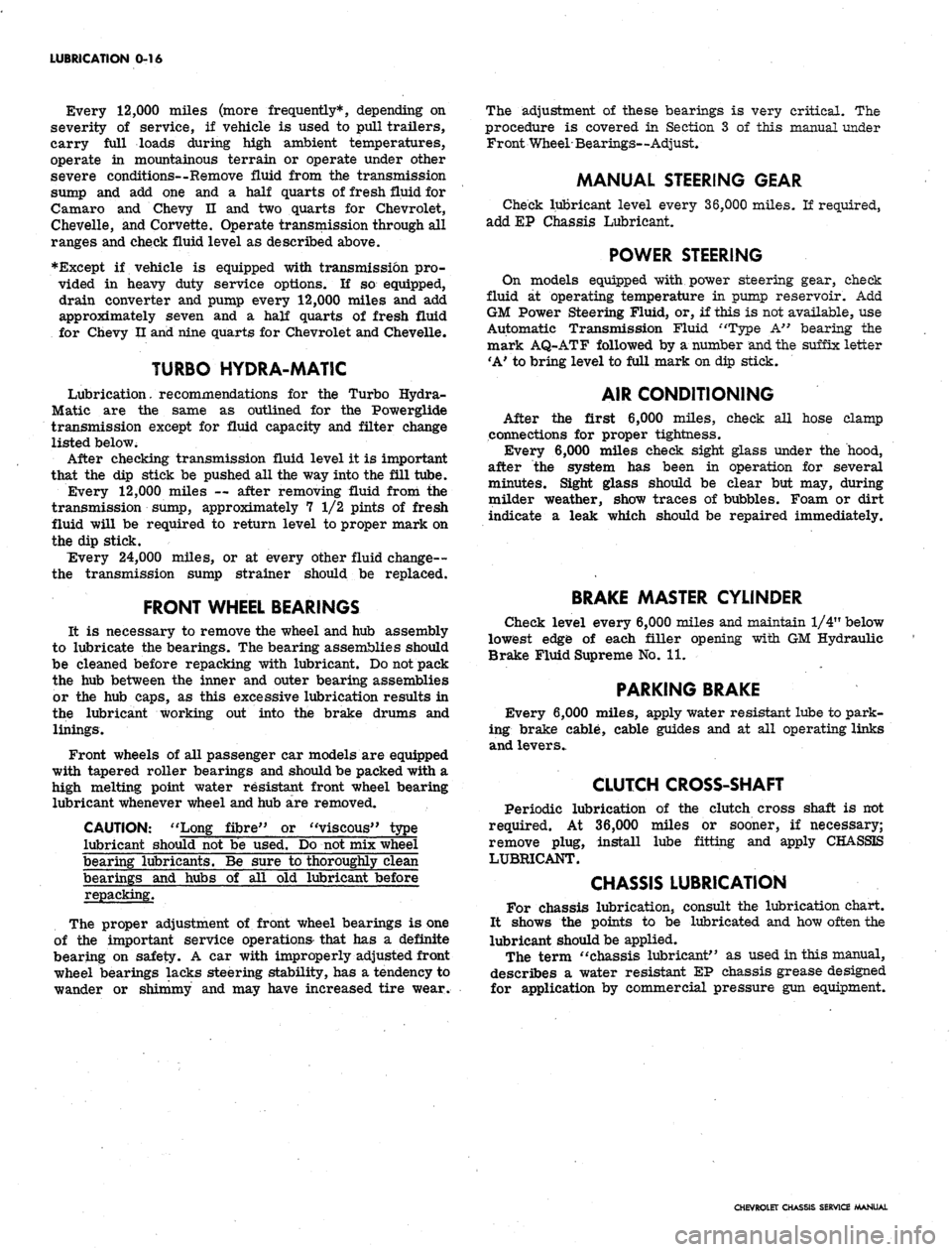
LUBRICATION 0-16
Every 12,000 miles (more frequently*, depending on
severity of service, if vehicle is used to pull trailers,
carry full loads during high ambient temperatures,
operate in mountainous terrain or operate under other
severe conditions--Remove fluid from the transmission
sump and add one and a half quarts of fresh fluid for
Camaro and Chevy II and two quarts for Chevrolet,
Chevelle, and Corvette. Operate transmission through all
ranges and check fluid level as described above.
•Except if vehicle is equipped with transmission pro-
vided in heavy duty service options. If so equipped,
drain converter and pump every 12,000 miles and add
approximately seven and a half quarts of fresh fluid
for Chevy II and nine quarts for Chevrolet and Chevelle.
TURBO HYDRA-MATIC
Lubrication. recommendations for the Turbo Hydra-
Matic are the same as outlined for the Powerglide
transmission except for fluid capacity and filter change
listed below.
After checking transmission fluid level it is important
that the dip stick be pushed all the way into the fill tube.
Every 12,000 miles — after removing fluid from the
transmission sump, approximately 7 1/2 pints of fresh
fluid will be required to return level to proper mark on
the dip stick.
Every 24,000 miles, or at every other fluid change--
the transmission sump strainer should be replaced.
FRONT WHEEL BEARINGS
It is necessary to remove the wheel and hub assembly
to lubricate the bearings. The bearing assemblies should
be cleaned before repacking with lubricant. Do not pack
the hub between the inner and outer bearing assemblies
or the hub caps, as this excessive lubrication results in
the lubricant working out into the brake drums and
linings.
Front wheels of all passenger car models are equipped
with tapered roller bearings and should be packed with a
high melting point water resistant front wheel bearing
lubricant whenever wheel and hub are removed.
CAUTION: "Long fibre" or "viscous" type
lubricant should not be used. Do not mix wheel
bearing lubricants. Be sure to thoroughly clean
bearings and hubs of all old lubricant before
repacking.
The proper adjustment of front wheel bearings is one
of the important service operations- that has a definite
bearing on safety. A car with improperly adjusted front
wheel bearings lacks steering stability, has a tendency to
wander or shimmy and may have increased tire wear.
The adjustment of these bearings is very critical. The
procedure is covered in Section 3 of this manual under
Front Wheel Bearings—Adjust,
MANUAL STEERING GEAR
Check lubricant level every 36,000 miles. If required,
add EP Chassis Lubricant.
POWER STEERING
On models equipped with power steering gear, check
fluid at operating temperature in pump reservoir. Add
GM Power Steering Fluid, or, if this is not available, use
Automatic Transmission Fluid "Type A" bearing the
mark AQ-ATF followed by a number and the suffix letter
'A'
to bring level to full mark on dip stick.
AIR CONDITIONING
After the first 6,000 miles, check all hose clamp
connections for proper tightness.
Every 6,000 miles check sight glass under the hood,
after the system has been in operation for several
minutes. Sight glass should be clear but may, during
milder weather, show traces of bubbles. Foam or dirt
indicate a leak which should be repaired immediately.
BRAKE MASTER CYLINDER
Check level every 6,000 miles and maintain 1/4" below
lowest edge of each filler opening with GM Hydraulic
Brake Fluid Supreme No. 11.
PARKING BRAKE
Every 6,000 miles, apply water resistant lube to park-
ing brake cable, cable guides and at all operating links
and levers.
CLUTCH CROSS-SHAFT
Periodic lubrication of the clutch cross shaft is not
required. At 36,000 miles or sooner, if necessary;
remove plug, install lube fitting and apply CHASSIS
LUBRICANT.
CHASSIS LUBRICATION
For chassis lubrication, consult the lubrication chart.
It shows the points to be lubricated and how often the
lubricant should be applied.
The term "chassis lubricant" as used in this manual,
describes a water resistant EP chassis grease designed
for application by commercial pressure gun equipment.
CHEVROLET CHASSIS SERVICE MANUAL
Page 165 of 659
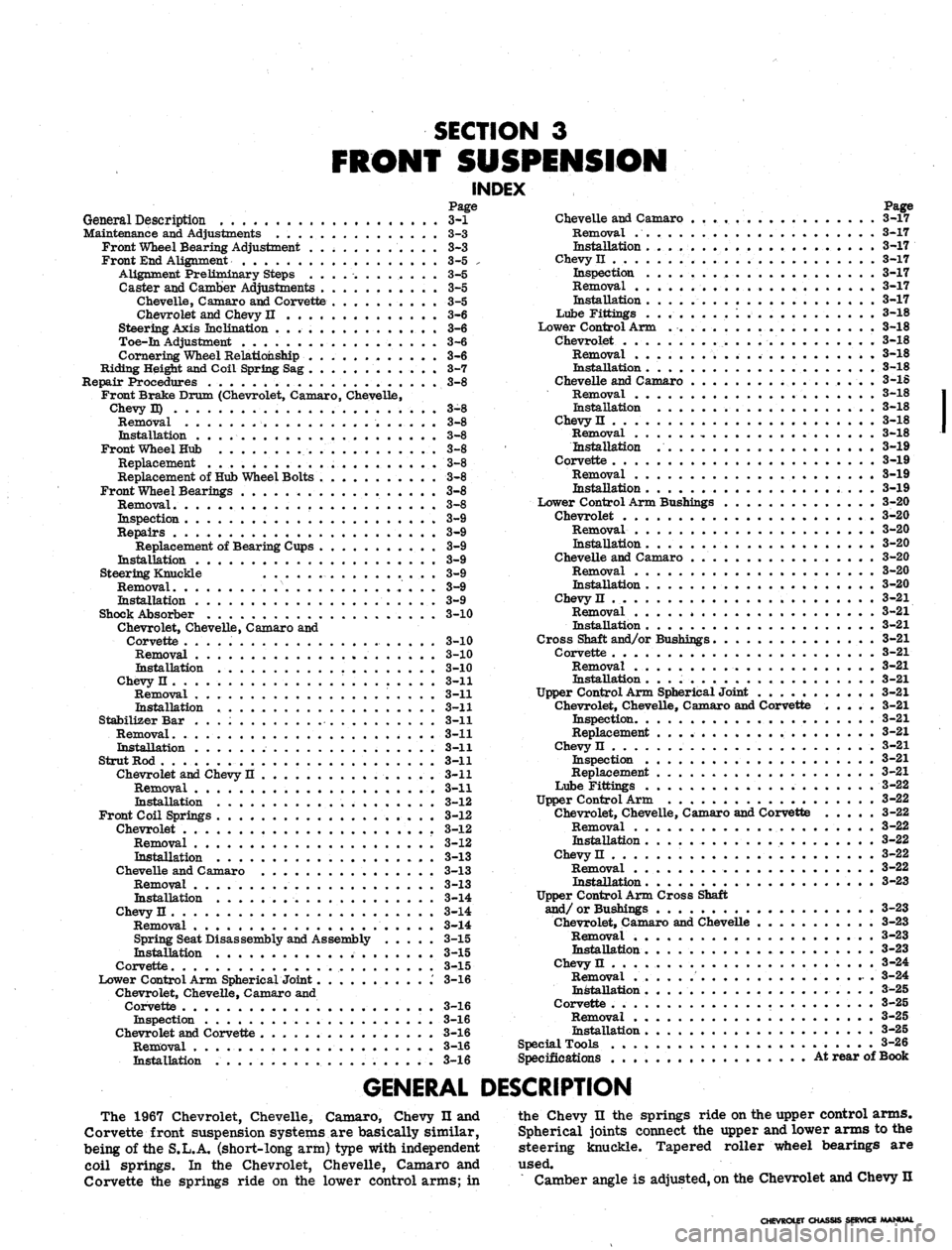
SECTION
3
FRONT SUSPENSION
INDEX
Page
General Description
. . . . 3-1
Maintenance and Adjustments
3-3
Front Wheel Bearing Adjustment
3-3
Front End Alignment
3-5 .
Alignment Preliminary Steps ............
3-5
Caster
and
Camber Adjustments
. . 3-5
Chevelle, Caxnaro
and
Corvette
3-5
Chevrolet and Chevy
II 3-6
Steering Axis Inclination
3-6
Toe-in Adjustment
3-6
Cornering Wheel Relationship
3-6
Riding Heigit
and
Coil Spring Sag
3-7
Repair Procedures
3-8
Front Brake Drum (Chevrolet, Camaro, Chevelle,
Chevy E)
. . 3-8
Removal
3-8
Installation
3-8
Front Wheel Hub
3-8
Replacement
. . . . . 3-8
Replacement
of
Hub Wheel Bolts
3-8
Front Wheel Bearings
. . 3-8
Removal
3-8
Inspection
3-9
Repairs
. . 3-9
Replacement
of
Bearing Cups
3-9
Installation
3-9
Steering Knuckle
. . . 3-9
Removal
3-9
Installation
3-9
Shock Absorber
3-10
Chevrolet, Chevelle, Camaro
and
Corvette
3-10
Removal
, . 3-10
Installation
3-10
Chevy
It 3-11
Removal
3-11
Installation
3-11
Stabilizer
Bar 3-11
Removal
3-11
Installation
3-11
Strut Rod
3-11
Chevrolet and Chevy
II 3-11
Removal
3-11
Installation
3-12
Front Coil Springs
3-12
Chevrolet
3-12
Removal
3-12
Installation
3-13
Chevelle
and
Camaro
3-13
Removal
3-13
Installation
3-14
Chevy H
3-14
Removal
3-14
Spring Seat Disassembly and Assembly
3-15
Installation
3-15
Corvette
3-15
Lower Control Arm Spherical Joint
.' 3-16
Chevrolet, Chevelle, Camaro and
Corvette
3-16
Inspection
. 3-16
Chevrolet and Corvette
3-16
Removal
3-16
Installation
3-16
Page
Chevelle
and
Camaro
3-17
Removal
3-17
Installation
. . . . 3-17
Chevy
II 3-17
Inspection
. 3-17
Removal
3-17
Installation
3-17
Lube Fittings
3-18
Lower Control Arm
. . . . 3-18
Chevrolet
. 3-18
Removal
3-18
Installation
3-18
Chevelle and Camaro
3-18
Removal
3-18
Installation
3-18
Chevy H
3-18
Removal
3-18
Installation
3-19
Corvette
3-19
Removal
3-19
mstallation
3-19
Lower Control Arm Bushings
3-20
Chevrolet
3-20
Removal
3-20
Installation
3-20
Chevelle and Camaro
. 3-20
Removal
3-20
Installation
3-20
Chevy H
3-21
Removal
* 3-21
InstaEation
3-21
Cross Shaft and/or Bushings
. 3-21
Corvette
3-21
Removal
3-21
Installation
3-21
Upper Control Arm Spherical Joint
3-21
Chevrolet, Chevelle, Camaro and Corvette
..... 3-21
Inspection.
3-21
Replacement
3-21
Chevy
II 3-21
Inspection
3-21
Replacement
3-21
Lube Fittings
3-22
Upper Control Arm
3-22
Chevrolet, Chevelle, Camaro
and
Corvette
3-22
Removal
3-22
Installation
3-22
Chevy H
3-22
Removal
3-22
Installation
3-23
Upper Control Arm Cross Shaft
and/or Bushings
3-23
Chevrolet, Camaro and Chevelle
3-23
Removal
. 3-23
Installation
3-23
Chevy H
3-24
Removal
3-24
Installation
. . . 3-25
Corvette
3-25
Removal
3-25
Installation
3-25
Special Tools
3-26
Specifications
...'..'
At rear of Book
GENERAL DESCRIPTION
The 1967 Chevrolet, Chevelle, Camaro, Chevy n and
Corvette front suspension systems are basically similar,
being of the
S.L.A.
(short-long arm) type with independent
coil springs. In the Chevrolet, Chevelle, Camaro and
Corvette the springs ride on the lower control arms; in
the Chevy II the springs ride on the upper control arms.
Spherical joints connect the upper and lower arms to the
steering knuckle. Tapered roller wheel bearings are
used.
Camber angle is adjusted, on the Chevrolet and Chevy n
CHEVROLET CHASSIS SERVICE MANIM
Page 167 of 659
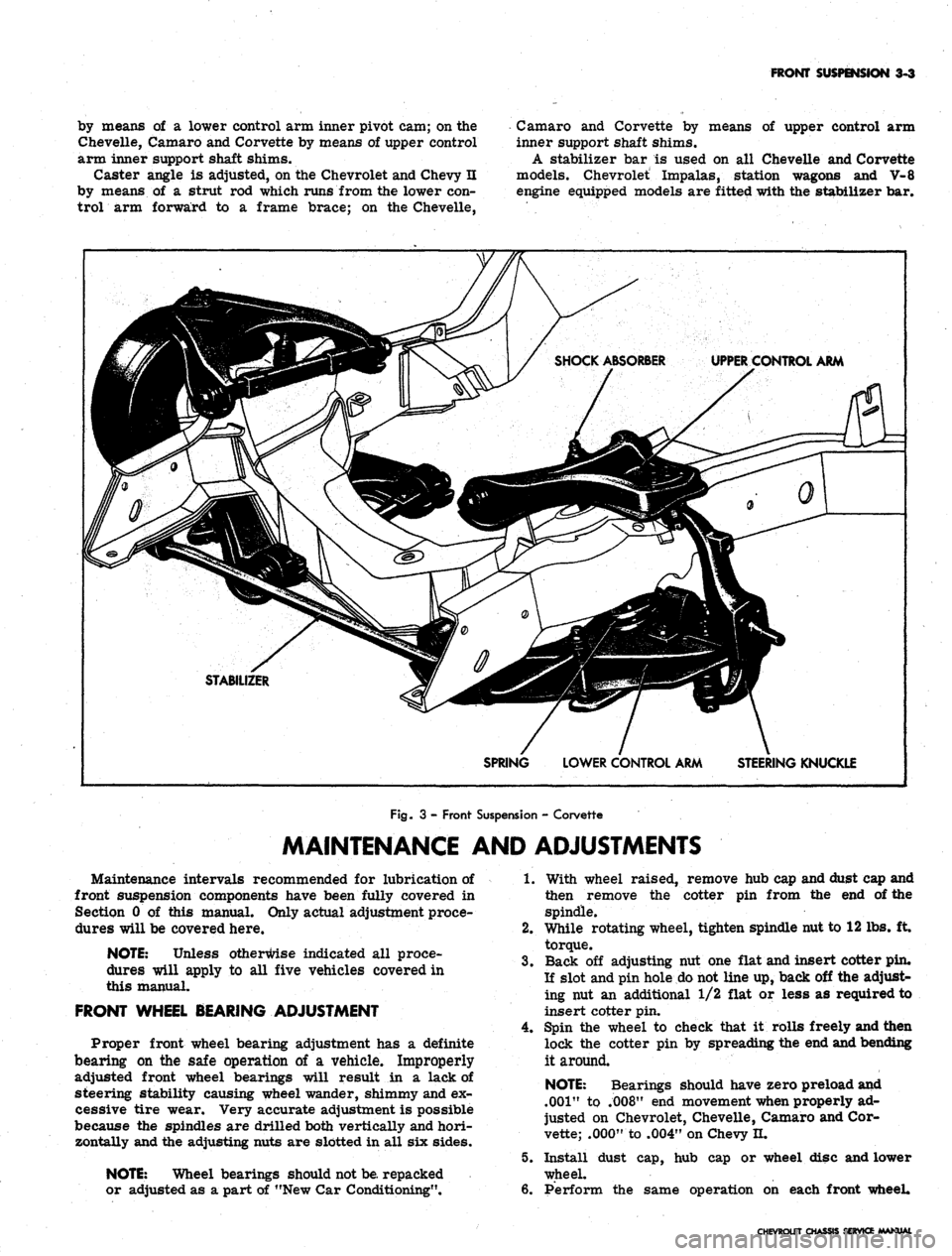
FRONT SUSPENSION 3-3
by means of a lower control arm inner pivot cam; on the
Chevelle, Camaro and Corvette by means of upper control
arm inner support shaft shims.
Caster angle is adjusted, on the Chevrolet and Chevy n
by means of a strut rod which runs from the lower con-
trol arm forward to a frame brace; on the Chevelle,
Camaro and Corvette by means of upper control arm
inner support shaft shims.
A stabilizer bar is used on all Chevelle and Corvette
models. Chevrolet Impalas, station wagons and V-8
engine equipped models are fitted with the stabilizer bar.
UPPER CONTROL ARM
STABILIZER
SPRING
LOWER CONTROL ARM
STEERING KNUCKLE
Fig.
3 - Front Suspension - Corvette
MAINTENANCE AND ADJUSTMENTS
Maintenance intervals recommended for lubrication of
front suspension components have been fully covered in
Section 0 of this manual. Only actual adjustment proce-
dures will be covered here.
NOTE:
Unless otherwise indicated all proce-
dures will apply to all five vehicles covered in
this manual.
FRONT WHEEL BEARING ADJUSTMENT
Proper front wheel bearing adjustment has a definite
bearing on the safe operation of a vehicle. Improperly
adjusted front wheel bearings will result in a lack of
steering stability causing wheel wander, shimmy and ex-
cessive tire wear. Very accurate adjustment is possible
because the spindles are drilled both vertically and hori-
zontally and the adjusting nuts are slotted in all six sides.
NOTE:
Wheel bearings should not
be.
repacked
or adjusted as a part of "New Car Conditioning".
1.
With wheel raised, remove hub cap and dust cap and
then remove the cotter pin from the end of the
spindle.
2.
While rotating wheel, tighten spindle nut to 12 lbs. ft
torque.
3.
Back off adjusting nut one flat and insert cotter pin.
If slot and pin hole do not line up, back off the adjust-
ing nut an additional 1/2 flat or less as required to
insert cotter pin.
4.
Spin the wheel to check that it rolls freely and then
lock the cotter pin by spreading the end and bending
it around.
NOTE:
Bearings should have zero preload and
.001"
to .008" end movement when properly ad-
justed on Chevrolet, Chevelle, Camaro and Cor-
vette; .000" to .004" on Chevy H.
5.
Install dust cap, hub cap or wheel disc and lower
wheel.
6. Perform the same operation on each front wheel.
CHEVROLET CHASSIS SERVICE MANUAL
Page 169 of 659
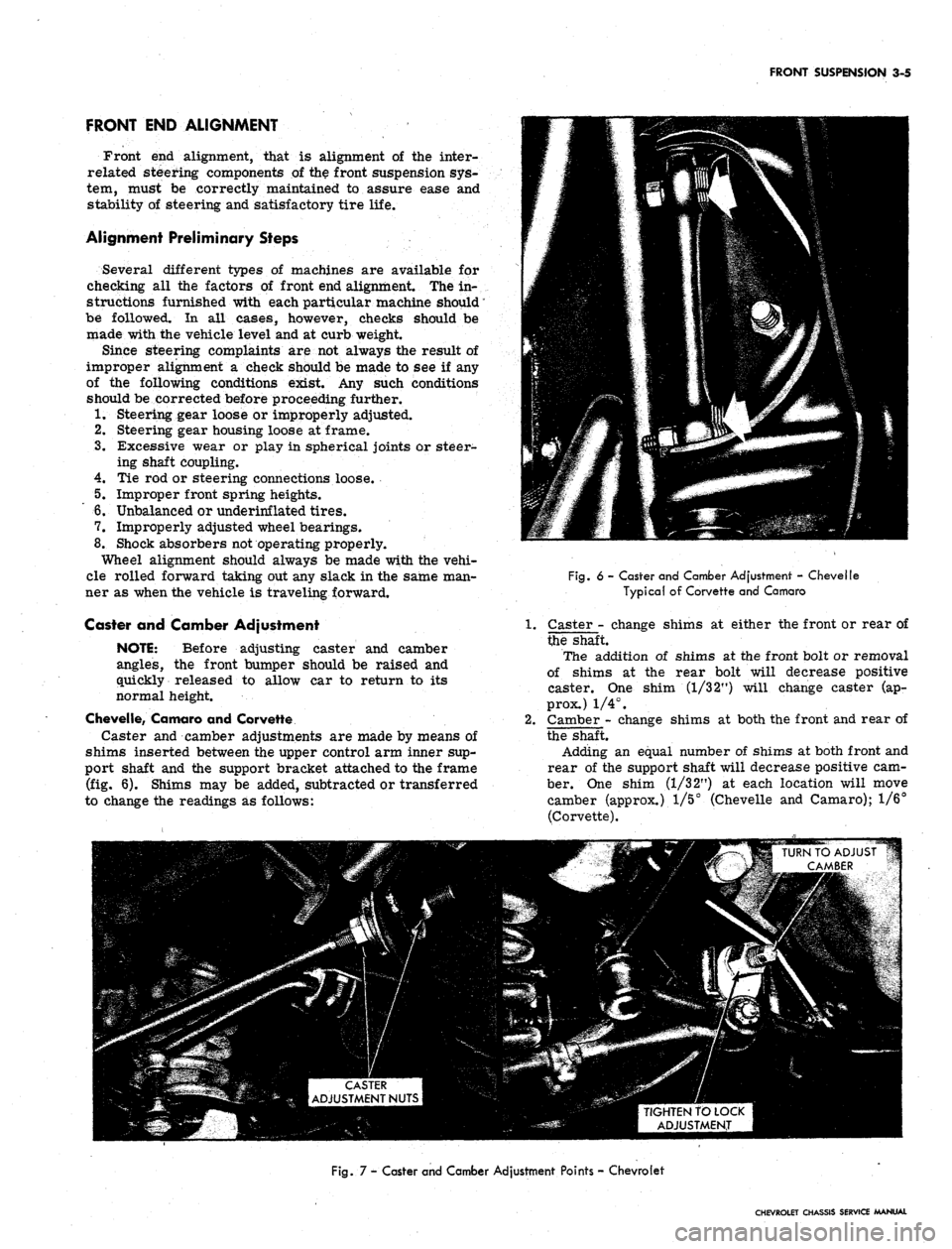
FRONT SUSPENSION 3-5
FRONT END ALIGNMENT
Front end alignment, that is alignment of the inter-
related steering components of the front suspension sys-
tem, must be correctly maintained to assure ease and
stability of steering and satisfactory tire life.
Alignment Preliminary Steps
Several different types of machines are available for
checking all the factors of front end alignment. The in-
structions furnished with each particular machine should
be followed. In all cases, however, checks should be
made with the vehicle level and at curb weight.
Since steering complaints are not always the result of
improper alignment a check should be made to see if any
of the following conditions exist. Any such conditions
should be corrected before proceeding further.
1.
Steering gear loose or improperly adjusted.
2.
Steering gear housing loose at frame.
3.
Excessive wear or play in spherical joints or steer-
ing shaft coupling.
4.
Tie rod or steering connections loose.
5.
Improper front spring heights.
6. Unbalanced or underinflated tires.
7.
Improperly adjusted wheel bearings.
8. Shock absorbers not operating properly.
Wheel alignment should always be made with the vehi-
cle rolled forward taking out any slack in the same man-
ner as when the vehicle is traveling forward.
Caster and Camber Adjustment
NOTE: Before adjusting caster and camber
angles, the front bumper should be raised and
quickly released to allow car to return to its
normal height.
Chevelle, Camaro and Corvette
Caster and camber adjustments are made by means of
shims inserted between the upper control arm inner sup-
port shaft and the support bracket attached to the frame
(fig. 6). Shims may be added, subtracted or transferred
to change the readings as follows:
Fig.
6 - Caster and Camber Adjustment - Chevelle
Typical of Corvette and Camaro
Caster - change shims at either the front or rear of
the shaft.
The addition of shims at the front bolt or removal
of shims at the rear bolt will decrease positive
caster. One shim (1/3 2") will change caster (ap-
prox.) 1/4°.
Camber - change shims at both the front and rear of
the shaft.
Adding an equal number of shims at both front and
rear of the support shaft will decrease positive cam-
ber. One shim (1/32") at each location will move
camber (approx.) 1/5° (Chevelle and Camaro); 1/6°
(Corvette).
TIGHTEN TO LOCK
ADJUSTMENT
Fig.
7 - Caster and Camber Adjustment Points - Chevrolet
CHEVROLET CHASSIS SERVICE MANUAL
Page 170 of 659
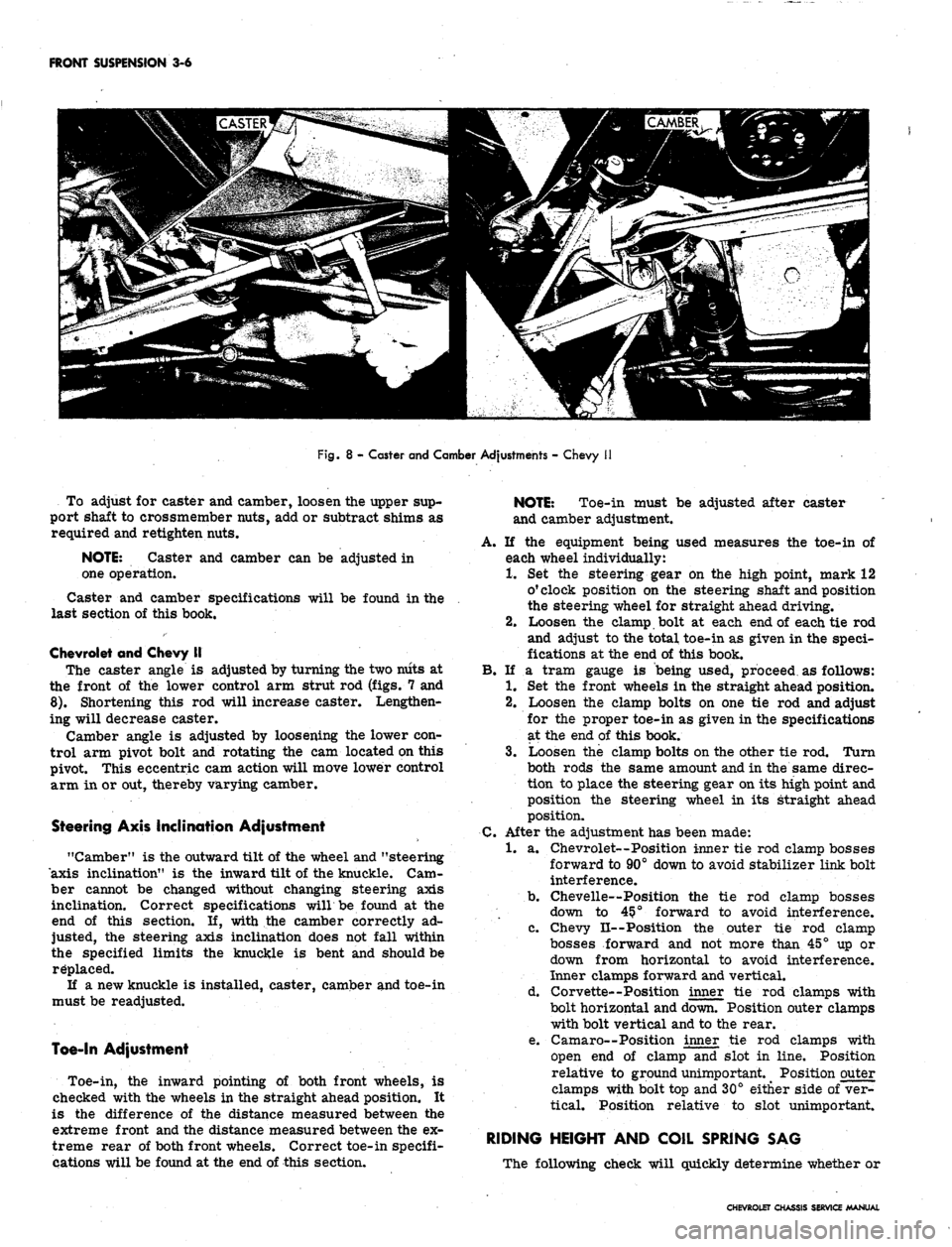
FRONT SUSPENSION 3-6
Fig.
8 - Caster and Camber Adjustments - Chevy
To adjust for caster and camber, loosen the upper sup-
port shaft to crossmember nuts, add or subtract shims as
required and retighten nuts.
NOTE:
Caster and camber can be adjusted in
one operation.
Caster and camber specifications will be found in the
last section of this book.
Chevrolet and Chevy II
The caster angle is adjusted by turning the two niits at
the front of the lower control arm strut rod (figs. 7 and
8).
Shortening this rod will increase caster. Lengthen-
ing will decrease caster.
Camber angle is adjusted by loosening the lower con-
trol arm pivot bolt and rotating the cam located on this
pivot. This eccentric cam action will move lower control
arm in or out, thereby varying camber.
Steering Axis Inclination Adjustment
"Camber" is the outward tilt of the wheel and "steering
axis inclination" is the inward tilt of the knuckle. Cam-
ber cannot be changed without changing steering axis
inclination. Correct specifications willbe found at the
end of this section. If, with the camber correctly ad-
justed, the steering axis inclination does not fall within
the specified limits the knuckle is bent and should be
replaced.
If a new knuckle is installed, caster, camber and toe-in
must be readjusted.
Toe-In Adjustment
Toe-in, the inward pointing of both front wheels, is
checked with the wheels in the straight ahead position. It
is the difference of the distance measured between the
extreme front and the distance measured between the ex-
treme rear of both front wheels. Correct toe-in specifi-
cations will be found at the end of this section.
NOTE:
Toe-in must be adjusted after caster
and camber adjustment.
A. If the equipment being used measures the toe-in of
each wheel individually:
1.
Set the steering gear on the high point, mark 12
o'clock position on the steering shaft and position
the steering wheel for straight ahead driving.
2.
Loosen the clamp bolt at each end of each tie rod
and adjust to the total toe-in as given in the speci-
fications at the end of this book.
B.
If a tram gauge is being used, proceed as follows:
1.
Set the front wheels in the straight ahead position.
2.
Loosen the clamp bolts on one tie rod and adjust
for the proper toe-in as given in the specifications
at the end of this book.
3.
Loosen the clamp bolts on the other tie rod. Turn
both rods the same amount and in the same direc-
tion to place the steering gear on its high point and
position the steering wheel in its straight ahead
position.
C.
After the adjustment has been made:
1.
a. Chevrolet—Position inner tie rod clamp bosses
forward to 90° down to avoid stabilizer link bolt
interference.
b.
Chevelle—Position the tie rod clamp bosses
down to 45?° forward to avoid interference.
c. Chevy II--Position the outer tie rod clamp
bosses forward and not more than 45° up or
down from horizontal to avoid interference.
Inner clamps forward and vertical.
d. Corvette--Position inner tie rod clamps with
bolt horizontal and down. Position outer clamps
with bolt vertical and to the rear.
e. Camaro—Position inner tie rod clamps with
open end of clamp and slot in line. Position
relative to ground unimportant. Position outer
clamps with bolt top and 30° either side of ver-
tical. Position relative to slot unimportant.
RIDING HEIGHT AND COIL SPRING SAG
The following check will quickly determine whether or
CHEVROLET CHASSIS SERVICE MANUAL
Page 173 of 659
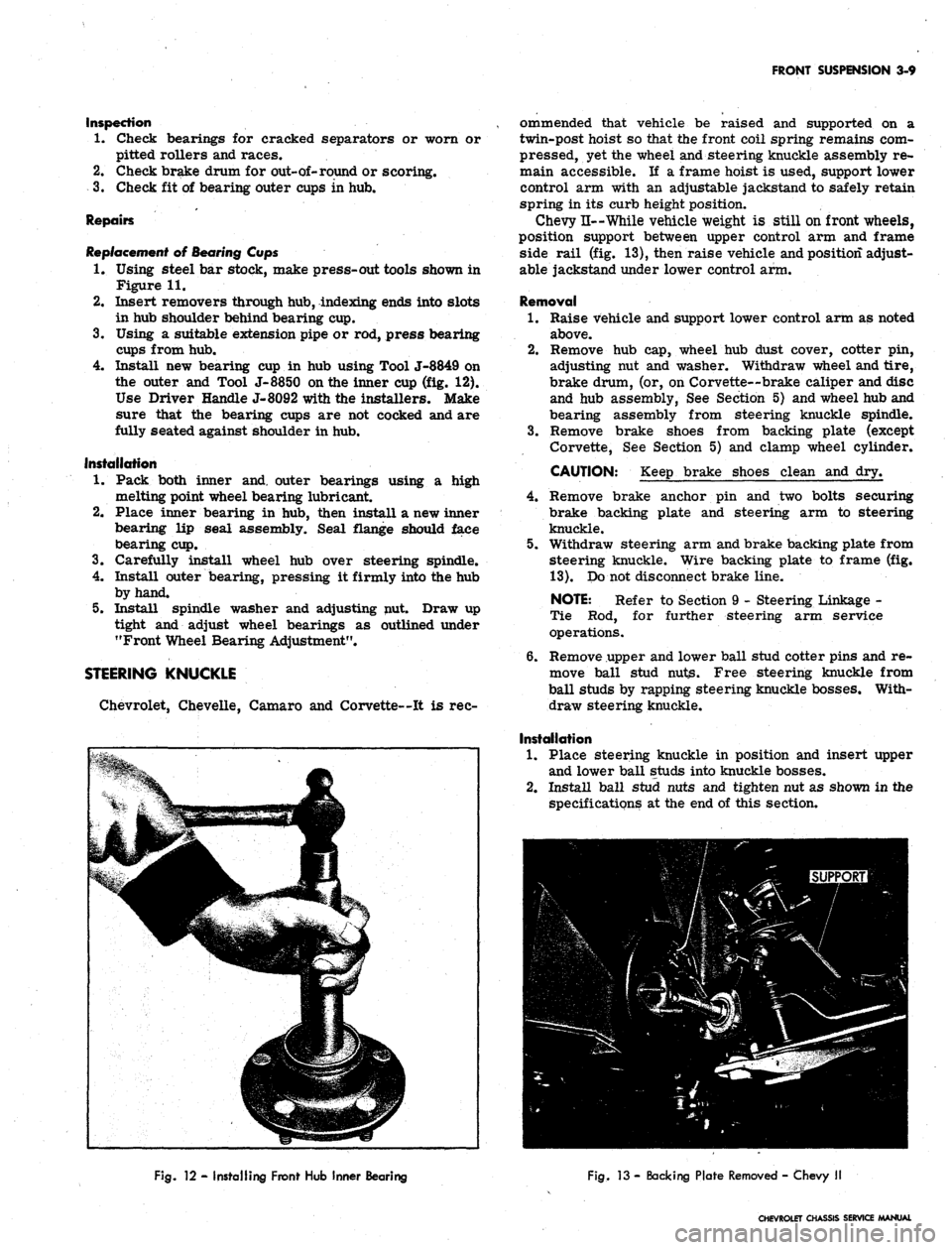
FRONT SUSPENSION 3-9
Inspection
1.
Check bearings for cracked separators or worn or
pitted rollers and races.
2.
Check brake drum for
out-of-
round or scoring.
3.
Check fit of bearing outer cups in hub.
Repairs
Replacement of Bearing Cups
1.
Using steel bar stock, make press-out tools shown in
Figure 11.
2.
Insert removers through hub, indexing ends into slots
in hub shoulder behind bearing cup.
3.
Using a suitable extension pipe or rod, press bearing
cups from hub.
4.
Install new bearing cup in hub using Tool J-8849 on
the outer and Tool J-8850 on the inner cup (fig. 12).
Use Driver Handle J-8092 with the installers. Make
sure that the bearing cups are not cocked and are
fully seated against shoulder in hub.
Installation
1.
Pack both inner and. outer bearings using a high
melting point wheel bearing lubricant.
2.
Place inner bearing in hub, then install a new inner
bearing lip seal assembly. Seal flange should face
bearing cup.
3.
Carefully install wheel hub over steering spindle.
4.
Install outer bearing, pressing it firmly into the hub
by hand.
5.
Install spindle washer and adjusting nut. Draw up
tight and adjust wheel bearings as outlined under
"Front Wheel Bearing Adjustment".
STEERING KNUCKLE
Chevrolet, Chevelle, Camaro and Corvette—It is rec-
ommended that vehicle be raised and supported on a
twin-post hoist so that the front coil spring remains com-
pressed, yet the wheel and steering knuckle assembly re-
main accessible. If a frame hoist is used, support lower
control arm with an adjustable jackstand to safely retain
spring in its curb height position.
Chevy n— While vehicle weight is still on front wheels,
position support between upper control arm and frame
side rail (fig. 13), then raise vehicle and position adjust-
able jackstand under lower control arm.
Removal
1.
Raise vehicle and support lower control arm as noted
above.
2.
Remove hub cap, wheel hub dust cover, cotter pin,
adjusting nut and washer. Withdraw wheel and tire,
brake drum, (or, on Corvette--brake caliper and disc
and hub assembly, See Section 5) and wheel hub and
bearing assembly from steering knuckle spindle.
3.
Remove brake shoes from backing plate (except
Corvette, See Section 5) and clamp wheel cylinder.
CAUTION: Keep brake shoes clean and dry.
4.
Remove brake anchor pin and two bolts securing
brake backing plate and steering arm to steering
knuckle.
5.
Withdraw steering arm and brake backing plate from
steering knuckle. Wire backing plate to frame (fig.
13).
Do not disconnect brake line.
NOTE: Refer to Section 9 - Steering Linkage -
Tie Rod, for further steering arm service
operations.
6. Remove upper and lower ball stud cotter pins and re-
move ball stud nuts. Free steering knuckle from
ball studs by rapping steering knuckle bosses. With-
draw steering knuckle.
Installation
1.
Place steering knuckle in position and insert upper
and lower ball studs into knuckle bosses.
2.
Install ball stud nuts and tighten nut as shown in the
specifications at the end of this section.
Fig.
12 - Installing Front Hub Inner Bearing
Fig.
13 - Backing Plate Removed - Chevy II
CHEVROLET CHASSIS SERVICE MANUAL
Page 174 of 659
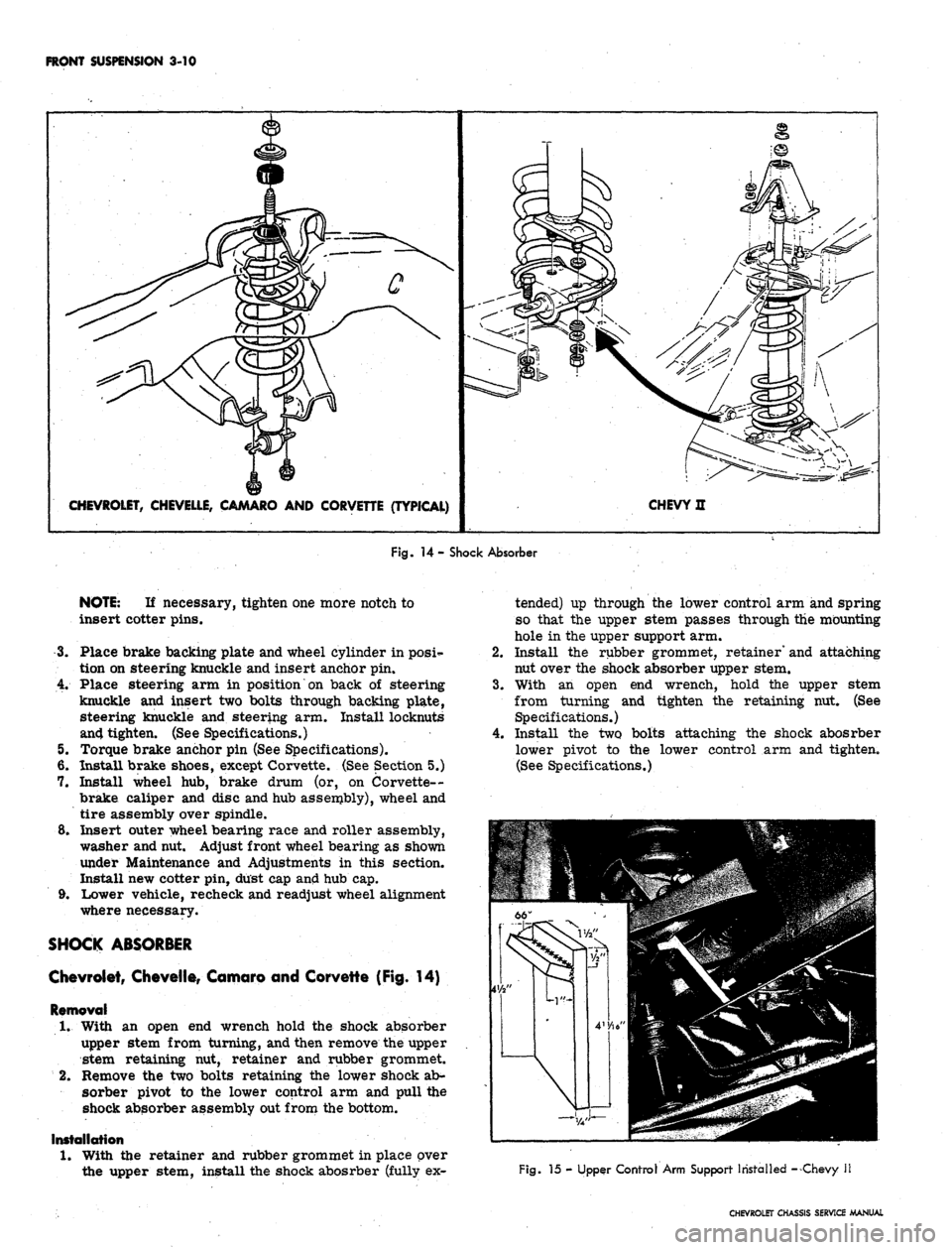
FRONT SUSPENSION 3-10
CHEVROLET, CHEVELLE, CAMARO AND CORVETTE (TYPICAL)
CHEVY H
Fig.
14- Shock Absorber
NOTE:
If necessary, tighten one more notch to
insert cotter pins.
3.
Place brake backing plate and wheel cylinder in posi*-
tion on steering knuckle and insert anchor pin.
4.
Place steering arm in position on back of steering
knuckle and insert two bolts through backing plate,
steering knuckle and steering arm. Install locknuts
and tighten. (See Specifications.)
5. Torque brake anchor pin (See Specifications).
6. Install brake shoes, except Corvette. (See Section 5.)
7. Install wheel hub, brake drum (or, on Corvette--
brake caliper and disc and hub assembly), wheel and
tire assembly over spindle.
8. Insert outer wheel bearing race and roller assembly,
washer and nut. Adjust front wheel bearing as shown
under Maintenance and Adjustments in this section.
Install new cotter pin, dust cap and hub cap.
9. Lower vehicle, recheck and readjust wheel alignment
where necessary.
SHOCK ABSORBER
Chevrolet, Chevelle, Comoro and Corvette (Fig. 14)
Removal
1.
With an open end wrench hold the shock absorber
upper stem from turning, and then remove the upper
stem retaining nut, retainer and rubber grommet.
2.
Remove the two bolts retaining the lower shock ab-
sorber pivot to the lower control arm and pull the
shock absorber assembly out from the bottom.
Installation
1.
With the retainer and rubber grommet in place over
the upper stem, install the shock abosrber (fully ex-
tended) up through the lower control arm and spring
so that the upper stem passes through the mounting
hole in the upper support arm.
2.
Install the rubber grommet, retainer' and attaching
nut over the shock absorber upper stem.
3.
With an open end wrench, hold the upper stem
from turning and tighten the retaining nut. (See
Specifications.)
4.
Install the two bolts attaching the shock abosrber
lower pivot to the lower control arm and tighten.
(See Specifications.)
Fig.
15 - Upper Control Arm Support Installed - Chevy II
CHEVROLET CHASSIS SERVICE MANUAL
Page 234 of 659
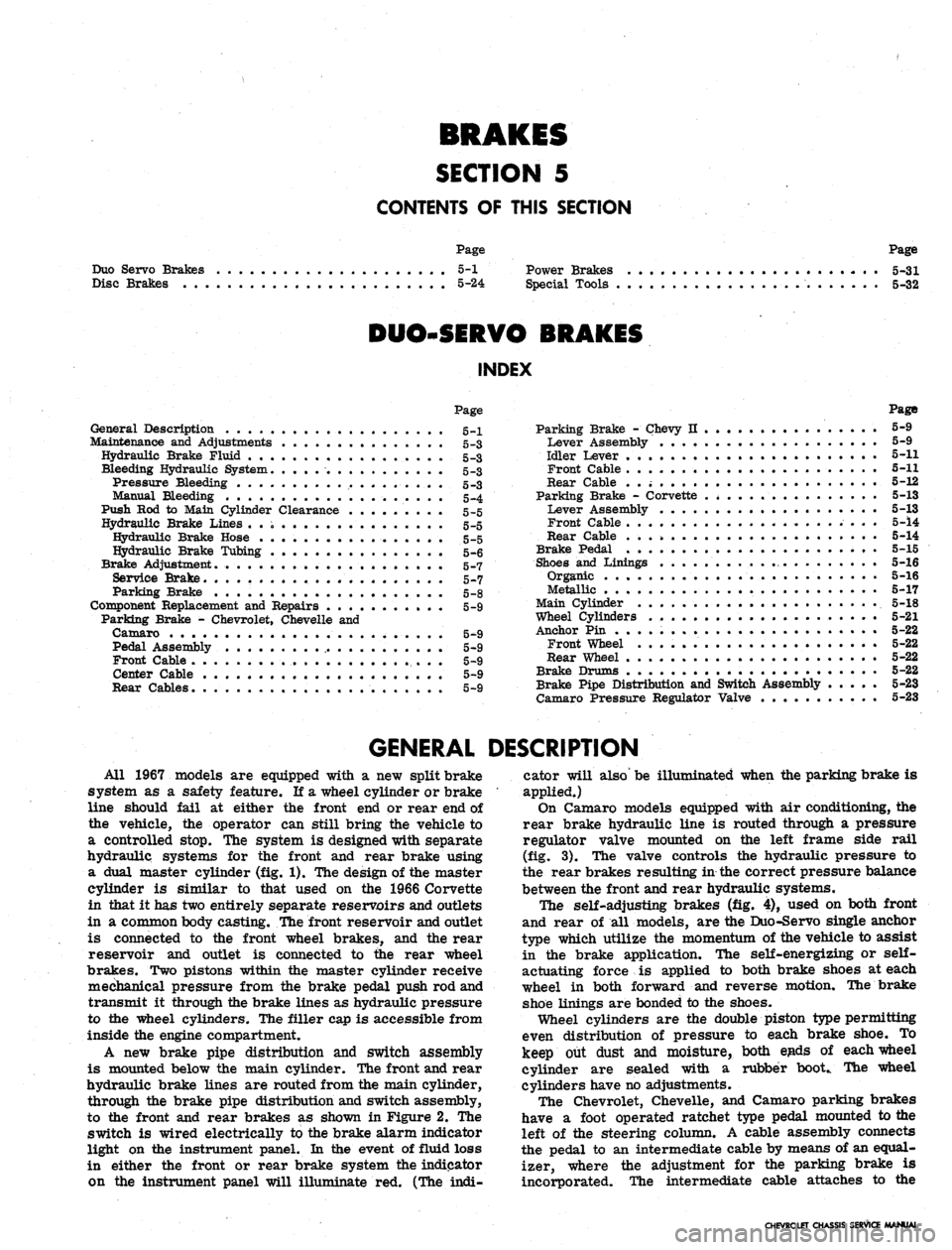
BRAKES
SECTION 5
CONTENTS OF THIS SECTION
Duo Servo Brakes
Disc Brakes
Page
5-1 Power Brakes
5-24 Special Tools
Page
5-31
5-32
DUO-SERVO BRAKES
INDEX
Page
General Description 5-1
Maintenance and Adjustments 5-3
Hydraulic Brake Fluid .. . 5-3
Bleeding Hydraulic System 5-3
Pressure Bleeding 5-3
Manual Bleeding 5_4
Push Rod to Main Cylinder Clearance 5-5
Hydraulic Brake Lines 5-5
Hydraulic Brake Hose 5-5
Hydraulic Brake Tubing 5-6
Brake Adjustment. .................... 5-7
Service Brake 5-7
Parking Brake 5-8
Component Replacement and Repairs 5-9
Parking Brake - Chevrolet, Chevelle and
Camaro 5^9
Pedal Assembly 5-9
Front Cable ,. . . 5-9
Center Cable 5-9
Rear Cables. . 5-9
Parking Brake - Chevy n 5-9
Lever Assembly 5-9
Idler Lever 5-11
Front Cable 5-11
Rear Cable . . ; 5-12
Parking Brake - Corvette 5-13
Lever Assembly . . . . 5-13
Front Cable 5-14
Rear Cable . . 5-14
Brake Pedal 5-15
Shoes and Linings 5-16
Organic 5-16
Metallic 5-17
Main Cylinder 5-18
Wheel Cylinders 5-21
Anchor Pin 5-22
Front Wheel 5-22
Rear Wheel 5-22
Brake Drums • 5-22
Brake Pipe Distribution and Switch Assembly . . . . . 5-23
Camaro Pressure Regulator Valve 5-23
GENERAL DESCRIPTION
All 1967 models are equipped with a new split brake
system as a safety feature. If a wheel cylinder or brake
line should fail at either the front end or rear end of
the vehicle, the operator can still bring the vehicle to
a controlled stop. The system is designed with separate
hydraulic systems for the front and rear brake using
a dual master cylinder (fig. 1). The design of the master
cylinder is similar to that used on the 1966 Corvette
in that it has two entirely separate reservoirs and outlets
in a common body casting. The front reservoir and outlet
is connected to the front wheel brakes, and the rear
reservoir and outlet is connected to the rear wheel
brakes. Two pistons within the master cylinder receive
mechanical pressure from the brake pedal push rod and
transmit it through the brake lines as hydraulic pressure
to the wheel cylinders. The filler cap is accessible from
inside the engine compartment.
A new brake pipe distribution and switch assembly
is mounted below the main cylinder. The front and rear
hydraulic brake lines are routed from the main cylinder,
through the brake pipe distribution and switch assembly,
to the front and rear brakes as shown in Figure 2. The
switch is wired electrically to the brake alarm indicator
light on the instrument panel. In the event of fluid loss
in either the front or rear brake system the indicator
on the instrument panel will illuminate red. (The indi-
cator will also' be illuminated when the parking brake is
applied.)
On Camaro models equipped with air conditioning, the
rear brake hydraulic line is routed through a pressure
regulator valve mounted on the left frame side rail
(fig. 3). The valve controls the hydraulic pressure to
the rear brakes resulting in the correct pressure balance
between the front and rear hydraulic systems.
The self-adjusting brakes (fig. 4), used on both front
and rear of all models, are the Duo-Servo single anchor
type which utilize the momentum of the vehicle to assist
in the brake application. The self-energizing or
self-
actuating force is applied to both brake shoes at each
wheel in both forward and reverse motion. The brake
shoe linings are bonded to the shoes.
Wheel cylinders are the double piston type permitting
even distribution of pressure to each brake shoe. To
keep out dust and moisture, both ejads of each wheel
cylinder are sealed with a rubber booC The wheel
cylinders have no adjustments.
The Chevrolet, Chevelle, and Camaro parking brakes
have a foot operated ratchet type pedal mounted to the
left of the steering column. A cable assembly connects
the pedal to an intermediate cable by means of an equal-
izer, where the adjustment for the parking brake is
incorporated. The intermediate cable attaches to the
CHEVROLET CHASSIS SERVICE MANUAL
Page 257 of 659
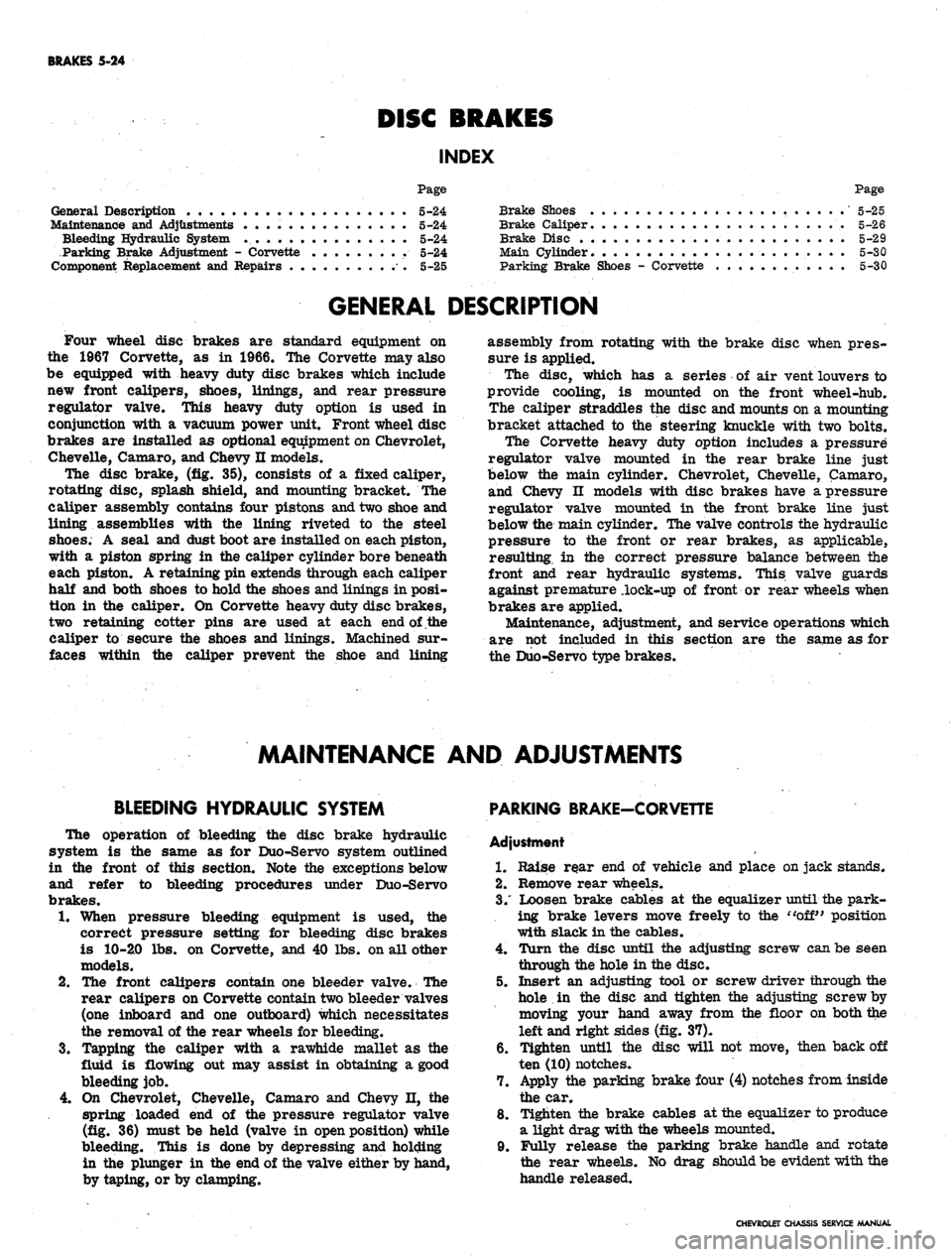
BRAKES
5-24
DISC BRAKES
INDEX
Page
General Description
. 5-24
Maintenance
and
Adjustments
5-24
Bleeding Hydraulic System
5-24
Parking Brake Adjustment
-
Corvette
5-24
Component Replacement
and
Repairs
5-25
Page
Brake Shoes
. . . . . 5-25
Brake Caliper
5-26
Brake Disc
5-29
Main Cylinder.
5-30
Parking Brake Shoes
-
Corvette
5-30
GENERAL DESCRIPTION
Four wheel disc brakes
are
standard equipment
on
the
1967
Corvette,
as in 1966. The
Corvette
may
also
be equipped with heavy duty disc brakes which include
new front calipers, shoes, linings,
and
rear pressure
regulator valve. This heavy duty option
is
used
in
conjunction with
a
vacuum power unit. Front wheel disc
brakes
are
installed
as
optional equipment
on
Chevrolet,
Chevelle, Camaro,
and
Chevy
II
models.
The disc brake,
(fig. 35),
consists
of a
fixed caliper,
rotating disc, splash shield,
and
mounting bracket.
The
caliper assembly contains four pistons and two shoe
and
lining assemblies with
the
lining riveted
to the
steel
shoes.
A
seal
and
dust boot
are
installed
on
each piston,
with
a
piston spring
in the
caliper cylinder bore beneath
each piston.
A
retaining pin extends through each caliper
half
and
both shoes
to
hold
the
shoes and linings
in
posi-
tion
in the
caliper.
On
Corvette heavy duty disc brakes,
two retaining cotter pins
are
used
at
each end
of the
caliper
to
secure
the
shoes
and
linings. Machined
sur-
faces within
the
caliper prevent
the
shoe
and
lining
assembly from rotating with
the
brake disc when pres-
sure
is
applied.
The disc, which
has a
series
of air
vent louvers
to
provide cooling,
is
mounted
on the
front wheel-hub.
The caliper straddles
the
disc and mounts
on a
mounting
bracket attached
to the
steering knuckle with
two
bolts.
The Corvette heavy duty option includes
a
pressure
regulator valve mounted
in the
rear brake line just
below
the
main cylinder. Chevrolet, Chevelle, Camaro,
and Chevy
n
models with disc brakes have
a
pressure
regulator valve mounted
in the
front brake line just
below
the
main cylinder. The valve controls
the
hydraulic
pressure
to the
front
or
rear brakes,
as
applicable,
resulting,
in the
correct pressure balance between
the
front
and
rear hydraulic systems. This valve guards
against premature .lock-up
of
front
or
rear wheels when
brakes
are
applied.
Maintenance, adjustment,
and
service operations which
are
not
included
in
this section
are the
same
as for
the Duo-Servo type brakes.
MAINTENANCE
AND
ADJUSTMENTS
BLEEDING HYDRAULIC SYSTEM
The operation
of
bleeding
the
disc brake hydraulic
system
is the
same
as for
Duo-Servo system outlined
in
the
front
of
this section. Note
the
exceptions below
and refer
to
bleeding procedures under Duo-Servo
brakes.
1.
When pressure bleeding equipment
is
used,
the
correct pressure setting
for
bleeding disc brakes
is 10-2.0
lbs. on
Corvette,
and 40 lbs. on all
other
models.
2.
The
front calipers contain
one
bleeder valve.
The
rear calipers
on
Corvette contain two bleeder valves
(one inboard
and one
outboard) which necessitates
the removal
of the
rear wheels
for
bleeding.
3.
Tapping
the
caliper with
a
rawhide mallet
as the
fluid
is
flowing
out may
assist
in
obtaining
a
good
bleeding
job.
4.
On
Chevrolet, Chevelle, Camaro
and
Chevy
II, the
spring loaded
end of the
pressure regulator valve
(fig.
36)
must
be
held (valve
in
open position) while
bleeding. This
is
done
by
depressing
and
holding
in
the
plunger
in the
end
of
the valve either
by
hand,
by taping,
or by
clamping.
PARKING BRAKE-CORVETTE
Adjustment
1.
Raise rear
end of
vehicle
and
place
on
jack stands.
2.
Remove rear wheels.
3/
Loosen brake cables
at the
equalizer until
the
park-
ing brake levers move freely
to the "off"
position
with slack
in the
cables.
4.
Turn
the
disc until
the
adjusting screw can
be
seen
through
the
hole
in the
disc.
5. Insert
an
adjusting tool
or
screw driver through
the
hole
in the
disc
and
tighten
the
adjusting screw
by
moving your hand away from
the
floor
on
both
the
left and right sides
(fig. 37).
6. Tighten until
the
disc will
not
move, then back
off
ten
(10)
notches.
7. Apply
the
parking brake four
(4)
notches from inside
the
car.
8. Tighten
the
brake cables
at the
equalizer
to
produce
a light drag with
the
wheels mounted.
9. Fully release
the
parking brake handle
and
rotate
the rear wheels.
No
drag should be evident with
the
handle released.
CHEVROLET CHASSIS SERVICE MANUAL
Page 277 of 659
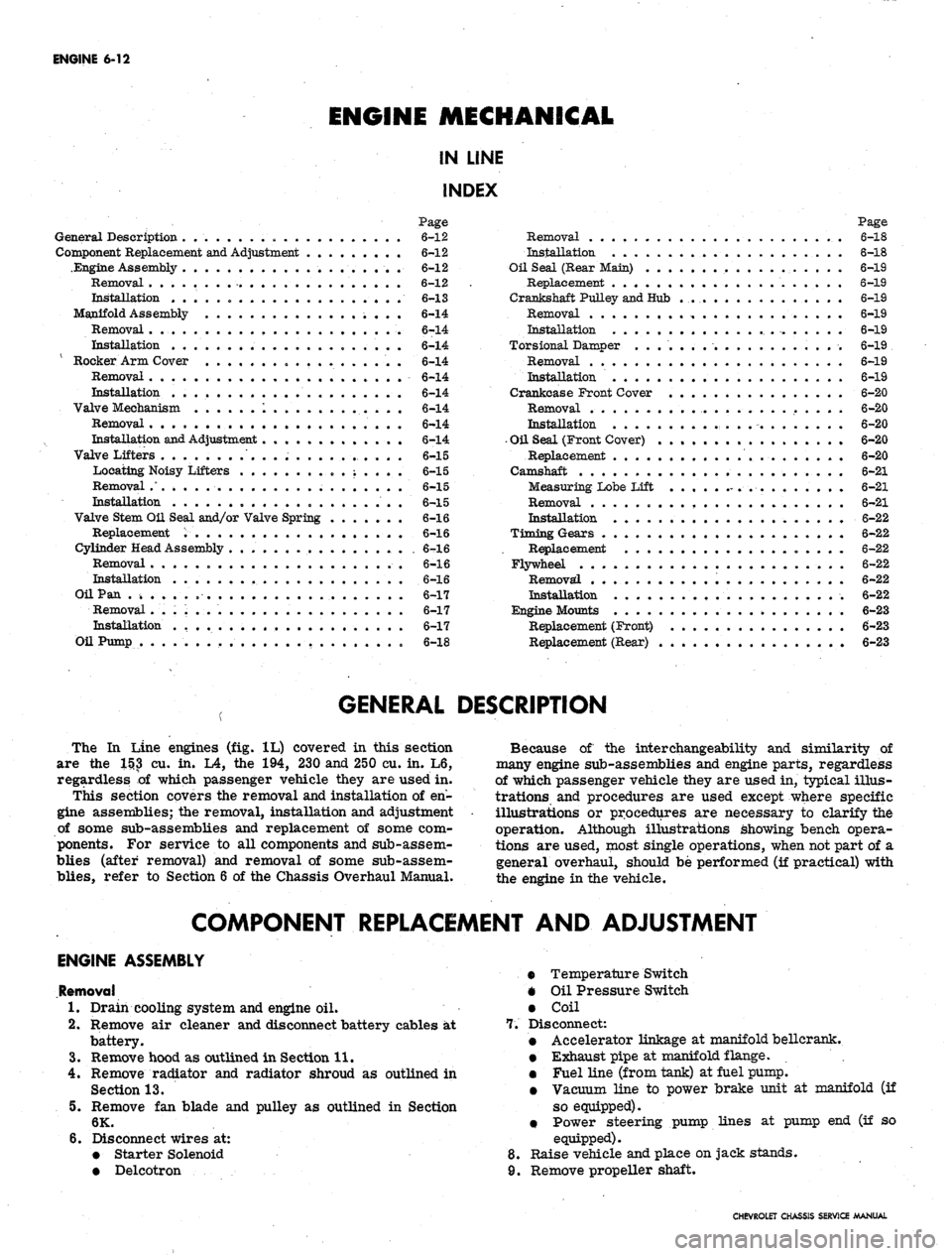
ENGINE
6-12
ENGINE
MECHANICAL
IN LINE
INDEX
Page
General Description . „ 6-12
Component Replacement and Adjustment 6-12
.Engine Assembly 6-12
Removal 6-12
Installation 6-13
Manifold Assembly 6-14
Removal . 6-14
Installation 6-14
Rocker Arm Cover . 6-14
Removal 6-14
mstallation . . . 6-14
Valve Mechanism
......
1 6-14
Removal 6-14
Installation and Adjustment . 6-14
Valve Lifters
..............
6-15
Locating Noisy Lifters
„.;....
6-15
Removal
.'.*...•
6-15
Installation . 6-15
Valve Stem Oil Seal and/or Valve Spring . 6-16
Replacement . 6-16
Cylinder Head Assembly . 6-16
Removal 6-16
Installation . 6-16
Oil Pan . » 6-17
Removal . . . ; . . 6-17
Installation
.........
. 6-17
Oil Pump . 6-18
Page
Removal . 6-18
Installation . 6-18
Oil Seal (Rear Main) . 6-19
Replacement 6-19
Crankshaft Pulley and Hub 6-19
Removal 6-19
Installation 6-19
Torsional Damper 6-19
Removal 6-19
Installation 6-19
Crankcase Front Cover . 6-20
Removal . 6-20
Installation 6-20
•
Oil Seal (Front Cover) 6-20
Replacement 6-20
Camshaft 6-21
Measuring Lobe Lift . ... .
.-.••.-.
6-21
Removal 6-21
Installation 6-22
Timing Gears
..••••.............••• 6—22
Replacement
6-22
Flywheel
6-22
Removal
* 6-22
Installation
6-22
Engine
Mounts
6-23
Replacement
(Front)
6-23
Replacement
(Rear)
. 6-23
GENERAL DESCRIPTION
The
In
Line engines
(fig. 1L)
covered
in
this section
are
the 1H3 cu. in. L4, the 194,
230
and
250
cu. in. L6,
regardless
of
which passenger vehicle they
are
used
in.
This section covers
the
removal
and
installation
of en-
gine assemblies;
the
removal, installation
and
adjustment
of some sub-assemblies
and
replacement
of
some
com-
ponents.
For
service
to all
components
and
sub-assem-
blies (after removal)
and
removal
of
some sub-assem-
blies,
refer
to
Section
6 of the
Chassis Overhaul Manual.
Because
of the
interchangeability
and
similarity
of
many engine sub-assemblies
and
engine parts, regardless
of which passenger vehicle they
are
used
in,
typical illus-
trations
and
procedures
are
used except where specific
illustrations
or
procedures
are
necessary
to
clarify
the
operation. Although illustrations showing bench opera-
tions
are
used, most single operations, when
not
part
of a
general overhaul, should
be
performed
(if
practical) with
the engine
in the
vehicle.
COMPONENT REPLACEMENT
AND
ADJUSTMENT
ENGINE ASSEMBLY
Removal
1.
Drain cooling system
and
engine
oil.
2.
Remove
air
cleaner
and
disconnect battery cables
at 7.
battery.
3.
Remove hood
as
outlined
in
Section 11.
4.
Remove radiator
and
radiator shroud
as
outlined
in
Section 13.
5.
Remove
fan
blade
and
pulley
as
outlined
in
Section
6K.
6. Disconnect wires
at:
• Starter Solenoid
8.
• Delcotron
9.
Temperature Switch
Oil Pressure Switch
Coil
Disconnect:
Accelerator linkage
at
manifold bellerank.
Exhaust pipe
at
manifold flange.
.
Fuel line (from tank)
at
fuel pump.
Vacuum line
to
power brake unit
at
manifold
(if
so equipped).
• Power steering pump lines
at
pump
end (if so
equipped).
Raise vehicle
and
place
on
jack stands.
Remove propeller shaft.
CHEVROLET CHASSIS SERVICE MANUAL